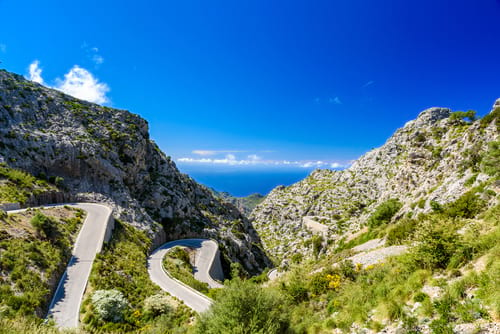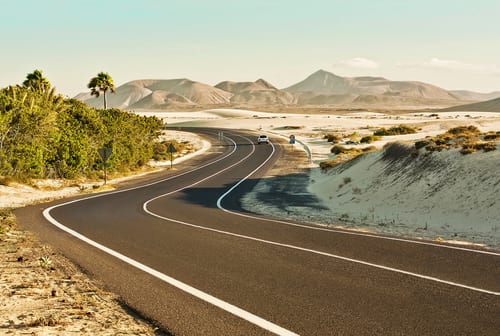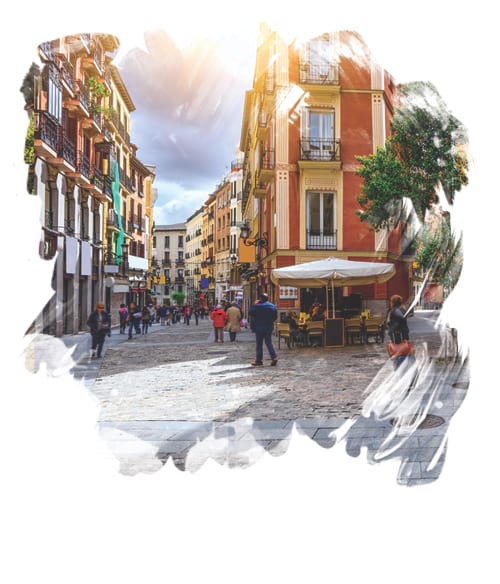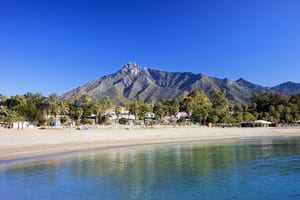Best value Spain car hire from top brands








Spain car hire tips

Where to pick up your car hire in Spain
There are over 340 car hire locations in Spain, and the most popular location is car hire in Malaga.

Top Spain car rental brands
The most popular car rental brands in Spain are Goldcar, Firefly, Record,
Centauro and Interrent.
Best time to hire a car in Spain
The cheapest months to pick up your car hire in Spain are January and November.

Local currency
Euro (EUR)

Side of road
Right

Car rental in Spain
Hire a car and take to the open road to
drive the scenic, stress-free roads of Spain.
Spain is the ultimate European holiday destination. From the Canary Islands to the Balearic Islands the diversity and differences are incredible. As one of the world’s most renowned destinations for spending a week in the sun, the hardest part of planning a holiday in Spain can be pinpointing exactly where to go. Each region offers such a variety of landscapes, delicacies and traditions, make sure to visit as many cities as you can during your stay.
Frequently Asked Questions about Car Hire in Spain
Dreaming of exploring Spain’s stunning coastlines, historic cities, and picturesque villages at your own pace? Hiring a car is a fantastic way to unlock the freedom of the open road. But we know you might have a few questions before you hit the highway! We’ve put together a comprehensive guide to the most popular and even some niche questions about car hire in Spain, all designed to make your journey smooth and stress-free.
What documents do I need to rent a car in Spain?
To pick up your hire car, you’ll generally need:
A valid driving licence: This must be your original, physical licence. If your licence isn’t from the EU and isn’t in a Roman alphabet (like English, Spanish, or German), you might also need an International Driving Permit (IDP). It’s always a good idea to check this beforehand to be safe!
A credit card in the main driver’s name: Most rental companies require a credit card for the security deposit, which covers things like fuel or potential damages. Debit cards are usually not accepted for this purpose. Make sure the card has enough available credit!
A valid ID (like your passport): This is essential for identity verification.
It’s always best to have a copy of your rental voucher or booking confirmation too, just in case!
How old do I need to be to rent a car in Spain? Are there any young driver fees?
The minimum age to rent a car in Spain is typically 21 years old, although some companies might rent to drivers as young as 19 or 20. However, most companies apply a “young driver surcharge” for anyone under 25 years old. This is usually an extra daily fee. When you search on our price comparison website select the age group you need and this will check for you.
There usually isn’t a maximum age, but some companies might have discretion based on a driver’s perceived ability.
A “senior driver surcharge” can sometimes apply too. Again, enter the right age in the car hire price comparison search and this will do this for you.
What are the fuel policy options for car rentals in Spain?
The most common fuel policies you’ll encounter are:
Full to Full: You pick up the car with a full tank and return it full. If you don’t return it full, you’ll be charged for the missing fuel plus a refuelling service fee.
Full to Empty (with refund for unused fuel): You pay for a full tank when you pick up the car. When you return it, you get a refund for any fuel left in the tank, but a service fee might be deducted.
Full to Empty (no refund): You pay for a full tank and are expected to return it as empty as possible, with no refund for unused fuel. This option can be more expensive if you don’t use all the fuel.
Always check the fuel policy when booking and confirm again on picking up.
What kind of car should I rent for my trip to Spain?
This really depends on your plans.
For city breaks (like Barcelona or Madrid): A mini or economy car is often best. They’re easier to navigate through narrow streets and find parking.
For exploring rural areas or scenic drives: A compact or mid-size car offers more comfort and power. If you’re heading into the mountains, consider a car with a bit more engine power.
For family holidays or lots of luggage: An SUV or a larger family car will give you the space you need.
For a bit of luxury: Spain also offers a range of luxury cars and convertibles, perfect for cruising the coastline!
Remember that manual transmission cars are most common in Spain, so if you prefer an automatic, make sure to book one well in advance, as they can be less available and sometimes cost more. This can be filtered out on our car hire price comparison searches.
What are the driving rules and regulations I should know for Spain?
Spain drives on the right-hand side of the road, and vehicles overtake on the left. Here are some key rules:
Speed Limits:
Motorways (Autopistas – AP): 120 km/h (75 mph)
Dual Carriageways (Autovías – E): 110 km/h (68 mph)
Out of town roads: 90 km/h (56 mph)
Built-up areas: 50 km/h (31 mph)
Always look out for local signage as limits can vary!
Seatbelts: Compulsory for all occupants, front and rear.
Children: Children under 12 or shorter than 1.35m must use an appropriate child restraint system and cannot travel in the front seat unless the rear seats are already occupied by children or the vehicle has no rear seats.
Mobile Phones: Illegal to use a handheld mobile phone while driving. Only a completely hands-free kit is allowed (earphone kits are not permitted).
Drinking and Driving: Spain has a strict limit of 0.05% blood alcohol content (0.03% for drivers with less than two years’ experience). Penalties are severe.
Headlights: Dipped headlights must be used in tunnels.
Horn Use: Illegal to use your horn in urban areas unless it’s an emergency. Flash your lights instead to warn other drivers.
Do I need special items in the car when driving in Spain?
Yes, by Spanish law, you should carry certain items in your vehicle:
Reflective Vest: One for each occupant, easily accessible (not in the boot). If you break down and need to leave your vehicle on the hard shoulder, you must wear this.
Two Warning Triangles: To be placed in front of and behind your vehicle if you break down or have an accident.
Headlamp Beam Deflectors: Depending on your car, you’ll need stickers or manual adjustment to prevent dazzling oncoming drivers.
Check with your rental company to ensure these are provided with your car, and then check when you pick up the rental car.
How do toll roads work in Spain?
Spain has excellent motorways (autopistas de peajes, prefixed with AP) which often have tolls. Tolls can usually be paid by:
Cash: Look for lanes marked with a hand or coin symbol. Obviously this will need Euros.
Credit Card: Look for lanes with a credit card symbol.
Automatic Payment (Via-T / Telepeaje): These lanes are marked with a ‘T’ or ‘Via-T’ symbol and are for vehicles equipped with an electronic transponder. Some rental companies offer these devices for an additional fee, allowing you to drive through without stopping.
If you don’t have a transponder, you usually take a ticket upon entering the motorway and pay when you exit, based on the distance travelled.
What’s parking like in Spanish cities?
Parking in Spanish cities can be tricky, especially in historic centres. Look out for:
Blue Zones (Zona Azul): These are metered parking zones, usually for a limited time (e.g., 2 hours). You’ll need to buy a ticket from a machine (parquímetro) or an attendant.
Green Zones (Zona Verde): These are often for residents, with stricter time limits or higher charges for non-residents.
Yellow Lines: Mean no parking at all!
Underground Car Parks (Parking Subterráneo): These are usually the safest and most convenient option in city centres, though they can be expensive.
Consider finding accommodation with parking and then use public transport if you’re staying within a major city.
Can I take my rental car to other countries from Spain?
This depends on the rental company and the specific countries you wish to visit. Generally, travel to neighbouring countries like France, Andorra, and Portugal is often permitted, but you might need to pay a cross-border surcharge.
Travel to more distant countries or Eastern Europe usually has more restrictions or higher fees. Always inform your rental company of your travel plans in advance and get confirmation that cross-border travel is allowed to avoid issues.
What kind of insurance is included with my car rental in Spain, and what extras should I consider?
When you rent a car in Spain, the basic insurance typically included is:
Third-Party Liability (TPL): This is legally required and covers damage or injury to other vehicles or people if you’re at fault.
Collision Damage Waiver (CDW): This limits your financial responsibility for damage to the rental car itself, but usually comes with an “excess” (deductible) amount you’d have to pay in case of damage.
Theft Protection (TP): This limits your liability if the car is stolen, also usually with an excess.
Extra insurance options to consider:
Zero Excess Insurance: This removes the deductible (excess) for CDW and TP, meaning you pay nothing if the car is damaged or stolen. This is highly recommended for peace of mind.
Personal Accident Insurance (PAI): Covers medical expenses for you and your passengers in case of an accident.
Tyre and Windscreen Cover: CDW often excludes damage to tyres, windows, roof, and undercarriage, so this separate cover can be valuable.
Check if your personal travel insurance or credit card offers any rental car coverage before buying additional insurance at the counter, as this can often be expensive. We offer car insurance as part of our booking process which is designed for our customers. Please check the details there.
Is it cheaper to rent a car at the airport or in the city centre?
Airport rentals are often slightly more expensive due to airport surcharges, but they offer the convenience of picking up your car right after you land. City centre offices might be cheaper, but you’ll need to arrange transport to get there, which could offset any savings. For many, the ease of airport pick-up and drop-off outweighs the small price difference. Run our car rental price comparison searches to see the differences.
Can I book a diesel car specifically?
It’s not always possible to guarantee a specific fuel type when you book. Most rental companies offer vehicles by “group” (e.g., Economy, Compact, SUV), and the exact model or fuel type depends on availability when you pick up. However, some suppliers do have specific vehicle groups that are guaranteed to be diesel. If you have a strong preference, it’s worth checking the specific vehicle group details or contacting the rental company directly. We do specifically list electric vehicles.
What happens if I return the car early? Will I get a refund?
Generally, no, you will not get a refund if you return the car early. Rental agreements are usually for the full duration you booked, and companies do not typically offer pro-rata refunds for unused time. If your plans change significantly before you pick up the car, it’s best to try and modify your booking in advance, though this might also lead to a new booking at current rates. Don’t forget that is many cases we offer free cancellation up to 48 hours before pickup.
Can I do a one-way rental in Spain (pick up in one city, drop off in another)?
Yes, many rental companies allow one-way rentals within Spain. This is great for road trips! However, a one-way fee usually applies, and the cost typically depends on the distance between the pick-up and drop-off locations. Some smaller local companies might not offer one-way rentals, if so we don’t list these suppliers as part of our price comparisons results.
Should I rent a car if I’m only visiting major Spanish cities like Barcelona or Madrid?
If your plan is solely to stay within a major city like Barcelona, Madrid, Seville, or Valencia, you likely don’t need a car. These cities have excellent public transport systems (metro, buses, trams) that are efficient and easy to use. Parking can be difficult and expensive, and traffic can be heavy.
However, a car is highly recommended if you plan to explore the surrounding regions and smaller towns, visit natural parks or rural areas, go on road trips along the coast or through the countryside or simply want flexibility for day trips outside the city.
What if I get a traffic fine in Spain?
If you receive a traffic fine, it’s usually an on-the-spot fine. For foreign drivers, Spanish authorities can sometimes demand immediate payment in cash. If you don’t have cash, you might be taken to the nearest ATM. If a fine comes through after your rental, the car hire company will usually charge your credit card for the fine amount plus an administration fee for processing it. It’s always best to pay fines promptly to avoid additional charges or complications.
What’s the deal with the new environmental stickers (Pegatinas DGT) in Spanish cities?
Some Spanish cities, especially larger ones like Madrid and Barcelona, have introduced low emission zones (Zonas de Bajas Emisiones – ZBE). Vehicles entering these zones may need an environmental sticker (distintivo ambiental or Pegatina DGT) to indicate their emission level. Rental cars typically come with the appropriate sticker, but it’s good to be aware of these zones if you plan to drive in city centres. Always check local regulations for the cities you plan to visit, and if in doubt ask at the desk when you pick up the car rental.
The Spanish islands – which one’s for you?


The Balearics
The Balearic Islands are great destinations for lovers of the classic holiday trio – sun, sea and sand.
Average flight time from the UK:
2 hours
Most popular place to hire a car in the Balearics:
Palma de Mallorca Airport
Average cost per day for a January rental in Mallorca:
£5
Average cost per day for a July rental in Mallorca:
£24
The landscape – what to expect:
Endless stretches of white sand, clear turquoise oceans, gorgeous tree-sheltered coves, pretty stone villages and verdant mountainous landscapes.
Climate
The weather is hot in peak season (June to September) but good weather is still possible in May and October. Winters tend to be cooler, so not great for lying on the beach.
Which island suits me best?
For a quiet, romantic retreat:
Menorca
For a busy and lively beach holiday:
Mallorca
For rustic villages and world class clubbing:
Ibiza
For celeb spotting and glamorous beaches:
Formentera


The Canaries
The Canary Islands, being nearer to Africa than Spain, offer a classic beach retreat with an exotic twist.
Average flight time from the UK:
4 hours
Most popular place to hire a car in the Canaries:
Tenerife South Airport
Average cost per day for a January rental in Tenerife:
£12
Average cost per day for a July rental in Tenerife:
£14
The landscape – what to expect:
Otherworldly volcanic formations, epic yellow sand dunes, wild and unforgettable beaches, fascinating black beaches and rugged, tropical forests.
Climate
Some of the most stable temperatures in the world mean that the Canaries are great for a winter retreat as well as a more traditional summer vacation.
Which island suits me best?
For lava shaped landscapes and dormant volcanoes:
Lanzarote
For beautiful drives and epic scenery:
Fuerteventura
For a classic beach holiday with a touch of adventure:
Tenerife
For diverse landscapes and world class conservation:
Gran Canaria
For mountains and forests and all things nature:
La Gomera
The centre of Spain
Madrid
The majestic city of Madrid sets itself apart from other capitals with its welcoming undercurrent and soulful, European vibes. It might not boast world-famous, esteemed landmarks, but its selling point is how it makes you feel when you are there.
Madrid’s fusion of larger-than-life, youthful nightlife with lazy, late (and good-value)
lunches provides a great balance of excitement and relaxation. Whether you want a
chilled afternoon filled with tapas or a late night in a flamenco theatre, Madrid will
tick all the boxes. If you prefer lying in sun-baked parks and wandering through small
cobbled alleyways, Madrid has these in abundance too.
Be aware, this landlocked city gets seriously hot in summer, and there is no easy escape
to the beach. Look out for a hotel with a pool, so you can cool off after a day of
sightseeing. Of course, make sure your rental car has air conditioning (and maybe even
consider renting a convertible!)

Book your Spain car hire now
 Book by phone
Book by phone
+44 203 3186 960

The capital of Catalonia
Barcelona
At the heart of Barcelona lies astounding architecture, unbeatable food and a welcoming soul. Not many European cities can boast the excitement of city life combined with chilled out beach vibes, and Barcelona achieves this mix effortlessly.
The green spaces and parks are unparalleled, and the many viewpoints – Bunkers del Carmel
and Montjuïc Castle to name a few – are breathtaking.
Gaudi has left his mark across the city, and his creations are definitely not to be missed (the inside of the Sagrada Familia is perhaps the most impressive and unexpected sight of all). However, Picasso also spent a lot of time in the city, and the museum dedicated to his early works is really worth a visit.


Popular cities


Alicante
Sitting on the Costa Blanca, there’s always a lively buzz around Alicante, and it’s the perfect place to plant your
toes in the sand.
Parts of the city feel village-like, whilst other parts are centred around the party lifestyle. It’s also a great base for a road trip to other Spanish cities: Valencia and Murcia aren’t far at all.
If you enjoy venturing away from resorts, then drive to the Guadalest Valley and find a tiny village in the mountains and unexpected views.


Malaga
Perfectly positioned on the Costa del Sol, Malaga is
sometimes unfairly stereotyped as a tourist trap. It’s actually the perfect beach destination with a great selection of historical monuments – making it easy to soak up some
sun and some culture.
The newly revived port has made the area even more desirable, and it’s within driving distance of some amazing places in the Malaga Province. Try out Ronda to see a town resting on top of a dramatic gorge.


Marbella
Around the corner from Malaga, Marbella is perhaps the
most glamorous resort in Andalusia, and it’s appeal isn’t hard to see.
The Golden Mile (which is actually about 5km long) is filled with classy bars and clubs, and the beaches are long, sandy and ready for hosting summer parties.
Most visiting Marbella will fly in to Malaga Airport, which is a 40-minute drive away.

Jaca
A jewel in the mountains
If you’re in the North of Spain, rent a car and follow the winding mountain roads to the
stunning archaic town of Jaca. Hidden and protected by the Pyrenees, Jaca is a more
unusual example of how the seasons can affect Spain. This village is perfectly suited to
summer tourists; yet when snow descends upon Jaca, it metamorphosizes into a Spanish ski
resort. Close to the French border, Jaca is built around a medieval fortress on the
River Aragon. There are some astonishing sights to uncover, including the remarkable
pentagonal citadel.







